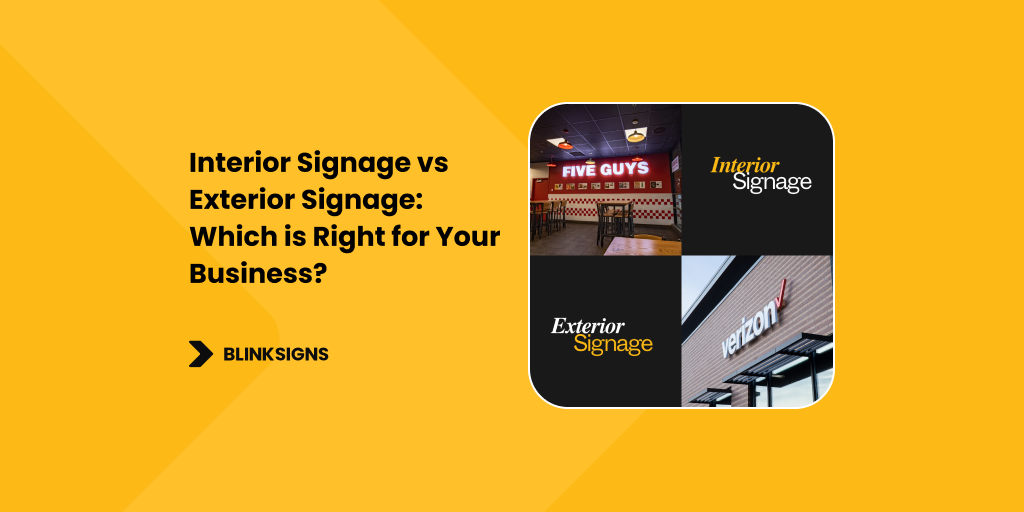
Interior Signage vs Exterior Signage: Which is Right for Your Business?
Signage is a critical communication tool for businesses, influencing everything from visibility and brand perception to customer engagement and loyalty. For any business, the right signage mix of interior and exterior can set it apart from the competition and create a lasting impression on potential customers. In busy commercial landscapes or quaint local communities, signage is key in guiding customers, communicating brand values, and enhancing customer trust.
Both interior and exterior signage are instrumental in building brand identity and guiding the customer journey. While interior signage focuses on improving the in-store experience, exterior signage is crafted to capture attention and drive foot traffic.
This article thoroughly compares these two types, Interior Signage vs Exterior signage, helping businesses select the most effective strategies for customer engagement, brand impact, and compliance.
What is Interior Signage?
Interior signage refers to signs placed within a business’s premises. These signs are often designed to enhance the customer experience by providing vital information, clear navigation, and an aesthetic that reflects the brand’s personality. Effective interior signage significantly shapes how customers perceive and interact with a business, offering practical guidance and brand reinforcement.
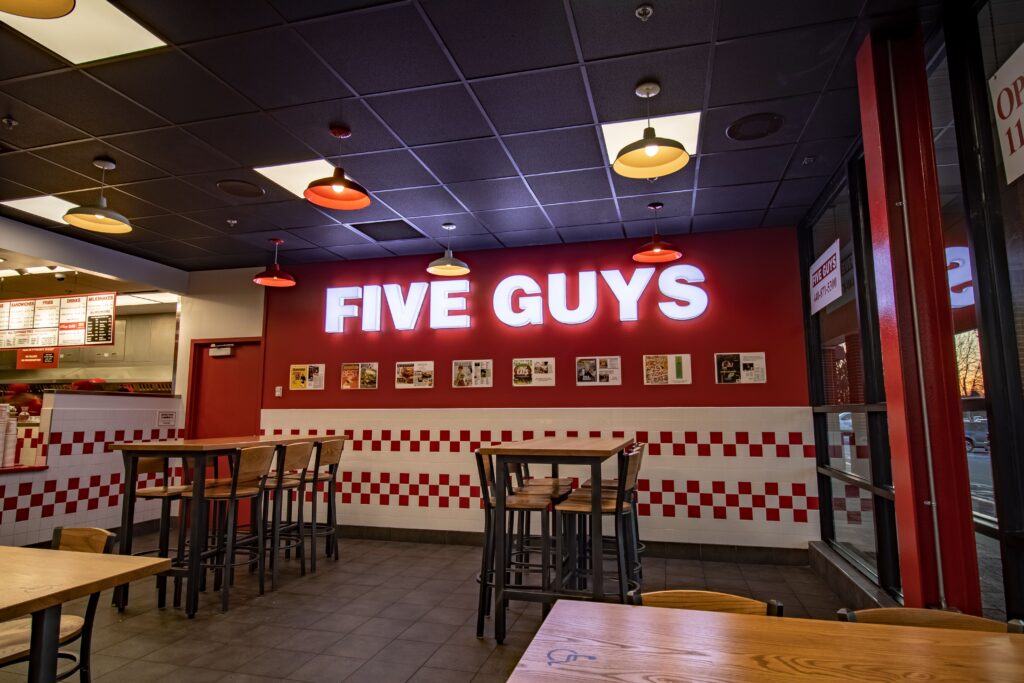
Five Guys Interior Signage
- Types of Interior Signage: Interior signage includes several types, such as wayfinding signs that guide customers to specific areas, lobby signs that greet visitors, directional signs, wall graphics, and safety-oriented signage like restroom or emergency signs. Each type serves a particular purpose, from improving in-store navigation to ensuring compliance with safety regulations.
- Benefits of Interior Signage: Interior signage enhances brand consistency by maintaining a cohesive look within the business while also supporting ADA compliance for accessibility. It allows companies to communicate directly with customers through informational signage, special offers, or promotional messages. Ultimately, interior signage improves the shopping experience by making spaces more navigable and visually appealing, strengthening customer engagement and trust.
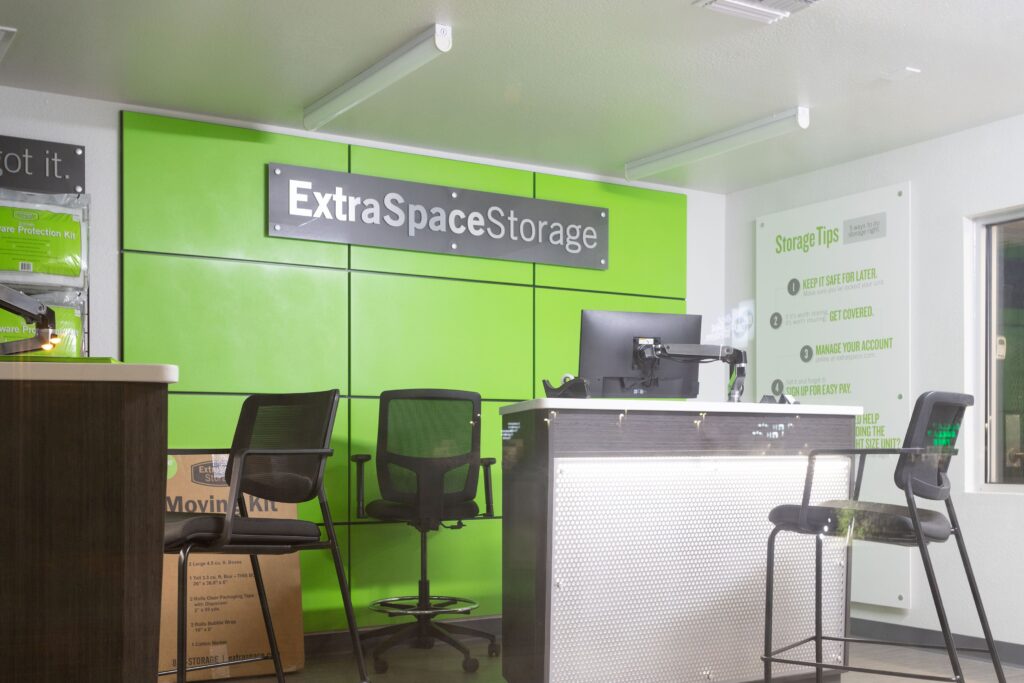
ExtraSpaceStorage Interior Signage
What is Exterior Signage?
Exterior signage encompasses the signage located outside a business, crafted to capture the attention of passersby and invite them in. Exterior signs are often the first point of contact with a brand and play a critical role in defining first impressions. An eye-catching exterior sign can create a memorable impact, drawing customers into the business while effectively communicating the brand’s value.
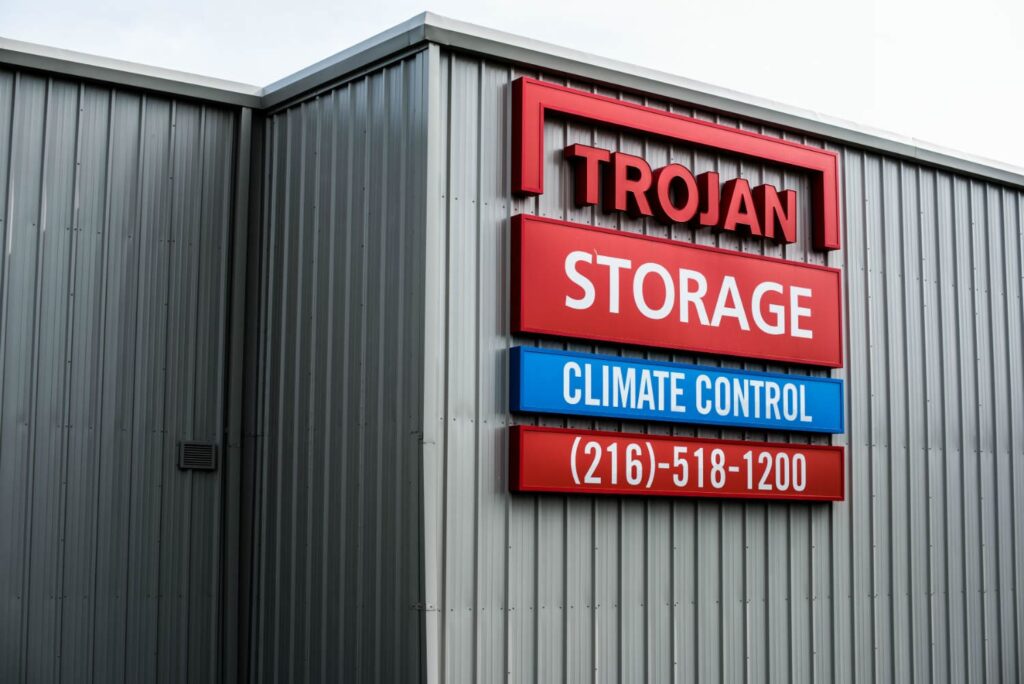
Trojan Storage External Signage
- Types of Exterior Signage: This category includes building-mounted signs, monument signs, towering pylon signs, banners, digital billboards, and temporary signs, such as those used for construction sites. Each type is designed for outdoor conditions, using materials and designs that ensure durability and high visibility.
- Benefits of Exterior Signage: Exterior signage boosts brand awareness and increases foot traffic by attracting the attention of nearby customers. It also contributes to local marketing by reinforcing brand presence in the community. Effective exterior signage helps businesses build a strong street presence, making them recognizable and memorable to regular and new customers.
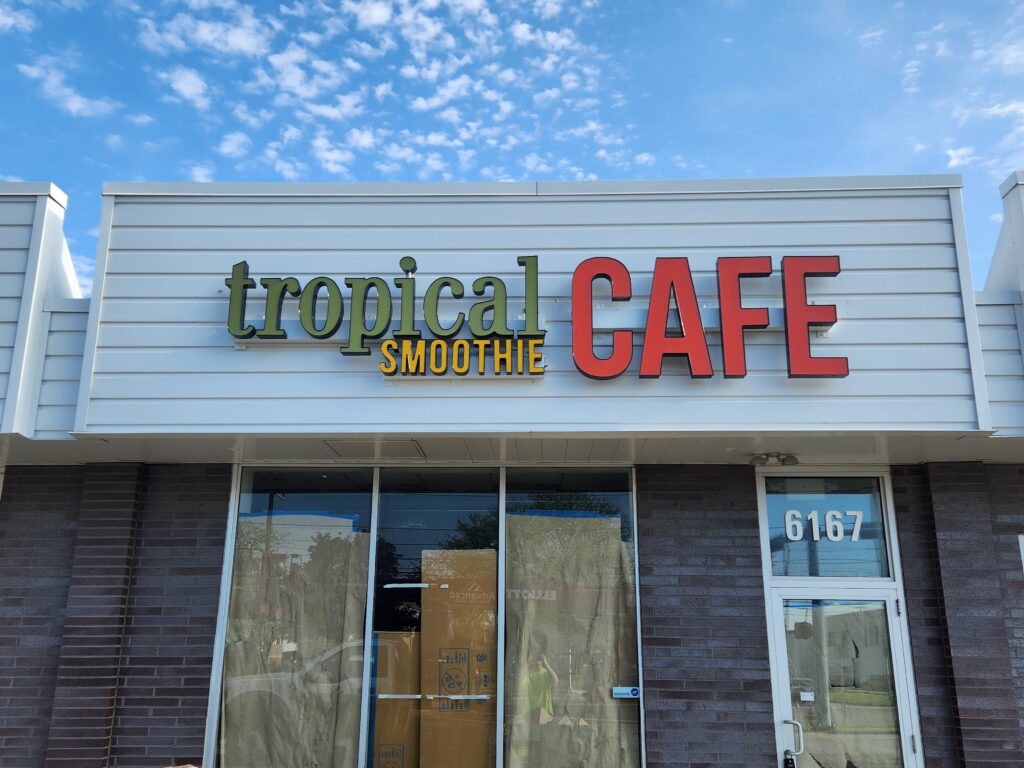
Tropical Smoothie Cafe Exterior Signage
Key Differences Between Interior and Exterior Signage
Interior and exterior signage fulfil distinct functions within a business’s communication strategy, with specific differences in design, purpose, and compliance requirements.
- Purpose and Placement: Interior signage is focused on enhancing the in-store experience and guiding customers throughout the space, while exterior signage is placed to attract attention from the outside, making it crucial for initial engagement.
- Design and Materials: Weather-resistant materials are prioritized for exterior signs to withstand the elements, whereas interior signs focus on aesthetics and readability within the business environment.
- Compliance and Regulations: ADA compliance, including Braille and non-glare finishes, is essential for interior signage, while zoning regulations, permits, and size restrictions typically apply to exterior signage. Compliance ensures that both signage types are accessible and within legal standards.
- Cost and ROI Considerations: While exterior signage often incurs higher costs due to materials and installation complexity, interior and exterior signage provide substantial returns on investment when aligned with business objectives. Interior signs support customer retention, while exterior signs help attract new foot traffic, enhancing overall profitability.
This table categorizes various types of signage, providing details on their purpose, ideal placement, and typical materials, which could help businesses determine the suitable signage options for their needs:
Signage Type |
Description |
Ideal Placement |
Common Materials |
Purpose/Benefits |
Wayfinding Signage |
Guides customers through a space, providing directions and location markers. |
Interior: Entrances, hallways, lobbies |
Acrylic, vinyl, glass |
Enhances customer navigation, improves accessibility, and reduces confusion within larger spaces. |
Lobby & Reception Signs |
The main entry areas display the brand logo or message to create a strong impression. |
Interior: Reception areas, lobbies |
Metal, acrylic, foam |
Builds brand identity and provides a professional appearance for first-time visitors. |
Wall Graphics |
Large graphics or decals are applied to walls for aesthetic or informational purposes. |
Interior – Showrooms, offices, lobbies |
Vinyl, adhesive-backed fabric |
Enhances branding, communicates messages visually, and creates an immersive experience. |
Digital Directory Signs |
Electronic directories display information on screens, often programmable. |
Interior: Office buildings, malls, hospitals |
LED screens, digital displays |
Provides flexible, up-to-date information that can be changed easily for events or building navigation. |
Emergency & Safety Signs |
Provides information related to safety, exits, and emergency protocols. |
Interior: exits, stairways, hallways |
Photoluminescent vinyl, aluminium |
Ensures safety compliance, guides individuals in emergencies, and meets regulatory standards (e.g., ADA). |
Building Signage |
Large outdoor signs represent a business’s name/logo on the building exterior. |
Exterior: Storefronts, office facades |
Aluminium, acrylic, stainless steel |
Increases brand visibility from afar, draws attention, and promotes business identity to passersby. |
Pylon & Monument Signs |
Free-standing structures that are placed at entry points or along roadways. |
Exterior – Roadside, parking lot entrances |
Concrete, steel, brick, aluminium |
It provides visibility from a distance, especially in high-traffic areas; it is ideal for businesses in complexes. |
Banners & Flags |
Temporary signage for events, promotions, or sales; often portable and versatile. |
Both Interior & Exterior |
Fabric, vinyl |
Promotes special offers, events, and sales effectively, with easy setup and takedown for temporary use. |
Electronic Message Centers |
Digital boards that display rotating messages, often with LED lighting. |
Exterior: High-traffic areas |
LED screens, polycarbonate covers |
Allows flexible content changes, highlights promotions, and captures attention with dynamic visuals. |
Window Graphics |
Graphics or Text are applied to windows to display promotions or enhance privacy. |
Exterior: Storefront windows |
Vinyl, perforated film |
Engages customers passing by, offers privacy, and promotes sales directly on glass surfaces. |
A-frame & Sidewalk Signs |
Portable signs placed outside businesses to attract walk-in traffic. |
Exterior: sidewalks entrances |
Metal, plastic, chalkboard |
Captures foot traffic, promotes daily specials, and provides flexible, easily changeable messaging. |
Directional Signs |
Guides traffic flow and indicates specific locations for visitors. |
Both Interior & Exterior |
Acrylic, aluminium, polycarbonate |
Improves customer experience by directing flow and marking key areas like parking, entrances, or amenities. |
Safety & Compliance Signs |
Ensures compliance with health, safety, and legal standards (e.g., ADA). |
Both Interior & Exterior |
Aluminum, vinyl, photoluminescent |
Protects the business legally, ensures customer safety, and meets mandatory standards like ADA compliance. |
Choosing the Right Signage for Your Business Needs
Choosing the proper signage requires evaluating several factors, including location, target audience, business objectives, and overall brand image. Each factor contributes to determining the most impactful signage mix.
Assessing Location and Audience: A business’s specific location, such as a shopping mall, street-front, or office building, greatly influences the type and style of signage needed. For example, a business in a high-traffic area may benefit more from prominent exterior signage, while businesses inside larger complexes may focus more on interior guidance.
Evaluating Customer Journey and Touchpoints: Understanding the customer journey is essential for determining the optimal signage strategy. Interior signage can improve the in-store experience by guiding customers and highlighting products, whereas exterior signage captures attention and draws customers in.
Budget and Return on Investment: It is crucial to analyze the cost of each signage type and consider potential ROI. Exterior signage may involve higher initial costs but can yield high returns through increased visibility. Interior signage, meanwhile, can enhance customer satisfaction, leading to repeat visits and higher long-term engagement.
Design and Visual Elements for Effective Signage
Effective signage relies on designs that align with the brand’s identity and visually appeal to customers. Strong design principles ensure that signage communicates clearly and reinforces brand values.
- Interior Signage Design: Interior signage design focuses on brand consistency, using colours, fonts, and graphics that reflect the brand. This consistency helps reinforce brand identity, making the space more welcoming and cohesive.
- Exterior Signage Design: For exterior signage, visibility is prioritized with high-contrast colours, bold fonts, and eye-catching graphics. Durability is also a factor, as exterior signs must remain vibrant and legible in various weather conditions.
- Lighting and Visual Impact: Lighting is essential for both types of signage. Backlit or halo-lit designs are ideal for exterior signage visibility, while ambient lighting enhances interior signs without creating glare. Adequate lighting maximizes the sign’s impact, ensuring it is legible and attractive in different settings.
- Key Visual Elements: Legibility, colour contrast, font choice, and placement are critical in signage types. Ensuring that signs are easily read from a distance or at a glance enhances their effectiveness, making them powerful tools for brand communication.
Materials and Construction for Interior and Exterior Signage
Materials and construction choices affect interior and exterior signage’s durability, aesthetic appeal, and longevity. High-quality materials ensure the sign remains effective over time.
- Materials for Interior Signage: Interior signs often use materials like acrylic, vinyl, glass, and foam, which provide a professional look suitable for indoor environments. These materials are easy to maintain and can be customized to reflect the brand’s personality.
- Materials for Exterior Signage: Exterior signs use weather-resistant materials like aluminium, polycarbonate, and other durable options to withstand outdoor conditions. These materials offer longevity, reducing the need for frequent replacements.
- Illumination Options: LED and neon lights are popular for both types of signage, providing visibility and aesthetic appeal. For exterior signs, lighting choices are made with outdoor exposure in mind, while indoor lighting is typically softer, ensuring visibility without causing glare.
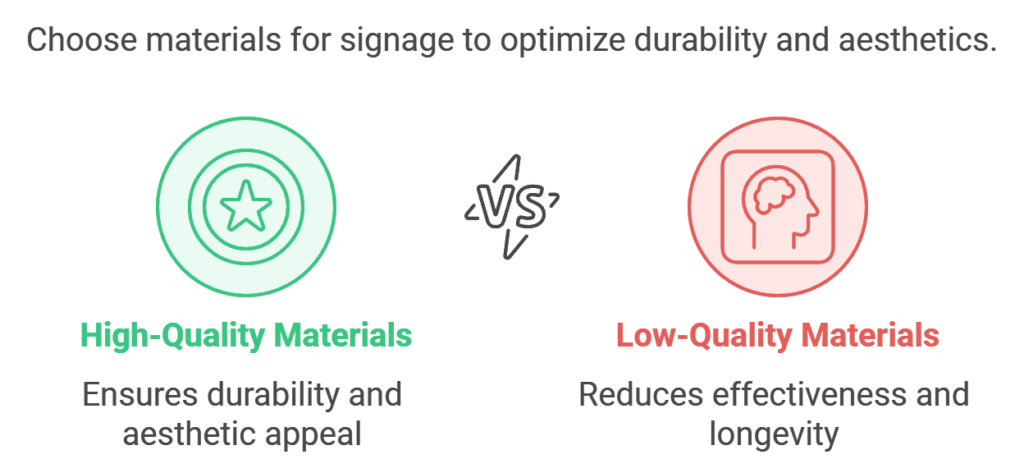
Material for Signage
Compliance and Legal Requirements for Interior and Exterior Signage
Meeting compliance standards is essential to avoid fines, ensure accessibility, and enhance brand reputation.
Interior Signage Compliance: Interior signage must meet ADA standards, including requirements for Braille, non-glare finishes, and specific height placements to ensure accessibility for all customers.
Exterior Signage Compliance: Exterior signage must comply with zoning restrictions, placement laws, and size limitations in commercial districts. Compliance ensures the signage is visible and safe without disrupting local aesthetics.
Environmental Regulations: Many municipalities require illuminated signage to meet light pollution ordinances, particularly near residential areas. Compliance with environmental standards ensures that signage remains effective without causing community disruption.
Maintenance and Durability Requirements
Regular maintenance helps signage retain its appearance, structural integrity, and compliance.
Routine Maintenance for Interior Signage: Regular cleaning and repairs keep interior signage visually appealing and compliant with brand standards. Maintenance also ensures the longevity of the materials.
Exterior Signage Durability: Exterior signs require additional UV protection, waterproofing, and impact resistance. This ensures they withstand natural elements like rain and sun exposure and remain effective for long periods.
Budgeting for Upkeep: Planning for maintenance and repairs is essential to extend signage life and maintain compliance. Regular upkeep ensures signage retains its impact, helping businesses maximize the return on their investment.
Environmental Impact and Sustainability Considerations
Sustainable signage practices reduce environmental impact and align with evolving customer expectations.
Eco-Friendly Material Options: Many businesses choose recyclable materials for interior and exterior signs, reducing their environmental footprint. Eco-friendly materials contribute to a positive brand image and meet customer expectations.
Energy-Efficient Lighting: LED lighting, suitable for both types of signage, saves energy while ensuring visibility. Energy-efficient options support sustainability efforts and reduce long-term costs.
Compliance with Local Environmental Regulations: Ensuring signage meets local environmental standards, like dark sky ordinances, reduces light pollution and minimizes disruption to residential areas, enhancing the business’s standing in the community.
Interactive and Engaging Signage for Enhanced Customer Experience
Interactive signage engages customers, offering a dynamic experience that can lead to higher engagement and brand loyalty.
- Interior Interactive Signage: Digital kiosks, touchscreen displays, and other interactive signage options are excellent for indoor use. They encourage customers to interact with the brand, making the in-store experience more engaging.
- Exterior Interactive Elements: Exterior signs can incorporate QR codes, digital screens, or AR features, inviting potential customers to engage with the business even before entering.
- Customer Engagement Benefits: Interactive signage enhances customer loyalty and engagement by providing a memorable and informative experience. It encourages customers to interact directly with the brand, increasing retention and conversion.
FAQs about exterior and interior signage
How can BlinkSigns help me decide between interior and exterior signage?
At BlinkSigns, we assess your business’s unique needs and environment, providing expert guidance on the signage mix that enhances visibility, customer engagement, and brand consistency. Whether in-store navigation or roadside visibility, we design signage strategies that deliver results.
Does BlinkSigns offer custom designs for both interior and exterior signage?
Absolutely! BlinkSigns specializes in creating custom signage solutions tailored to your brand identity. Our design team collaborates with you to ensure each interior or exterior sign reflects your vision and appeals to your target audience.
How do I know if my signage will comply with local regulations?
Our BlinkSigns team stays current on local signage regulations, including ADA standards and zoning requirements. We handle the permitting process, ensuring that your signage complies with all relevant codes, saving you time and hassle.
Can BlinkSigns integrate digital and interactive features into my signage?
BlinkSigns offers digital and interactive signage options for interior and exterior applications. We provide solutions like digital kiosks, LED screens, and QR code integrations to engage customers and provide a memorable experience.
Does BlinkSigns offer eco-friendly signage options?
We are committed to sustainability. BlinkSigns offers eco-friendly materials and energy-efficient lighting solutions that align with green initiatives, helping you make environmentally conscious choices without compromising quality.
How can interior and exterior signage work together for a cohesive brand experience?
BlinkSigns specializes in creating signage that complements your brand identity across all touchpoints. Our team designs a cohesive system where exterior signage draws in customers and interior signage enhances their in-store experience, reinforcing your brand message seamlessly.
How long does it take to install interior vs. exterior signage?
Installation times vary depending on the complexity and type of signage. At BlinkSigns, we provide a detailed timeline for each project and efficient installation processes for indoor and outdoor signs to minimize disruptions to your business operations.
What materials does BlinkSigns recommend for long-lasting exterior signage?
BlinkSigns uses durable, weather-resistant materials for exterior signage, such as aluminium, polycarbonate, and UV-protected finishes. These materials withstand the elements, ensuring that your signs remain vibrant and effective over time.
How can I measure the effectiveness of my signage with BlinkSigns’ support?
BlinkSigns offers guidance on measuring signage performance. From tracking foot traffic increases to monitoring customer interaction with digital signs, we help you gather data to assess the impact of your signage investment.
Does BlinkSigns provide maintenance services for both interior and exterior signs?
Yes, BlinkSigns offers comprehensive maintenance services. Our team ensures that your interior and exterior signage remains clean, functional, and compliant, helping extend its lifespan and effectiveness.
Conclusion: Deciding Between Interior and Exterior Signage for Your Business
Interior and exterior signage both play vital roles in branding and customer engagement. By understanding each type’s unique benefits, businesses can create a balanced approach supporting in-store and external engagement goals. BlinkSigns offers expert guidance in developing impactful, compliant, and visually appealing signage for any business need.
Let BlinkSigns help you craft signage solutions that enhance brand presence and engage customers at every stage of their journey.